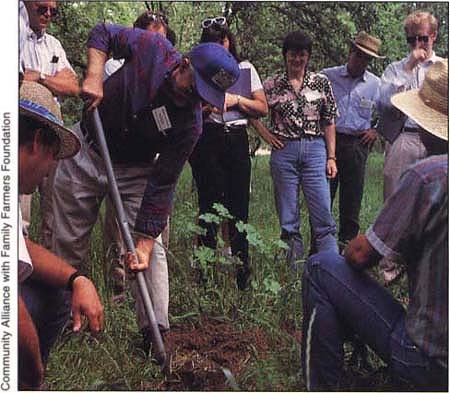All Issues
Science briefs
Publication Information
California Agriculture 49(1):4-4.
Published January 01, 1995
PDF | Citation | Permissions
Full text
BIOS recognized for innovation
A program helping Merced County almond growers farm with fewer pesticides was recently honored for its efforts in integrated pest management by California's Department of Pesticide Regulation (DPR). The Biologically Integrated Orchard Systems (BIOS) program in Merced County was one of five recipients of DPR's “IPM Innovator” award.
UC's Sustainable Agriculture Research and Education Program (SAREP) in Davis provides technical information, such as managing cover crops, beneficial insects and earthworms, to the 26 Merced County almond growers enrolled in this project. Two new BIOS projects have been added, in which 18 walnut growers in Yolo and Solano counties and 25 almond growers in Stanislaus County are enrolled.
All three BIOS projects employ guidelines and monitoring techniques developed by the UC Statewide Integrated Pest Management Project.
BIOS is coordinated by the nonprofit Community Alliance with Family Farmers Foundation.
The project evolved from Merced County farm advisor Lonnie Hendricks' 6-year monitoring project of orchards growing almonds with and without synthetic pesticides (see page 5 ).
Hilmar almond grower and BIOS management team member Glenn Anderson, center, looks for soil health indicators such as earthworms in an orchard planted with cover crops.
UC to update pest containment facilities
To expand research on pest management using biological control and biotechnology, UC plans to construct containment and quarantine facilities in Davis and Riverside. These facilities will support a comprehensive, integrated program designed to draw upon the unique expertise and strengths of each campus.
The two facilities will be separate but complementary. Both will support research into environmentally compatible pest management strategies. UC Riverside's insectary and quarantine facility is designed to accelerate research leading to the development of biological and other natural pest controls. The UC Davis containment and quarantine facility will address research on bioengineering, genetically engineered organisms and other biotechnology applications.
A total of $35 million will be required to complete the two facilities, with costs being shared equally by the U.S. Department of Agriculture and UC. So far, $4 million has been appropriated — $3.9 million in federal funds and $290,000 in state funds.
The 39,000-assigned-square-foot (asf) lab proposed for the Davis campus will provide the state-of-the-art containment needed for biotechnology research. “Currently there is no facility like it on either campus,” said Frank Zalom, acting director of the Center for Pest Management Research and Extension.
He noted that existing UC research facilities have not kept pace with advancing technology. “Both biotechnology and biocontrol are important areas that we can't adequately address with what we have currently,” Zalom said.
In addition to being dilapidated and over-crowded, UC Riverside's existing facility, built in 1930, has only 577 asf of containment and is rated seismically poor. Lack of space has forced UC Riverside to turn down requests from outside agencies to evaluate potential biological control agents for pests including alfalfa weevil and silverleaf whitefly.
“We are seriously hampered in our ability to serve California agriculture and in fact, the entire western region of the United States,” said Michael Rust, chairman of UC Riverside's Department of Entomology. “The new 17,000-asf facility will considerably expand and accelerate our research programs, improve faculty's ability to attract grants, and increase UC Riverside's ability to recruit the strongest potential candidates for future positions.”





